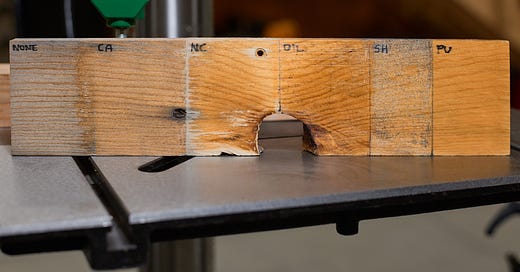How do wood finishes hold up?
A quick 18-month experiment to shed light on traditional woodworking lore.
I have a couple of hobbies that I don’t talk about much; chief among them is woodworking. It’s a unique, slow-burn craft that manages to stay relevant in the world of flying cars, quantum computers, and superhuman AI. Alas, the hobby is also common enough that the internet “wow” factor isn’t there.
For the most part, the science of wood is pretty straightforward, but all the conflicting advice about wood finishes can drive you nuts. I needed real answers, so I took a piece of scrap softwood, finished it using a couple different chemistries, and then nailed it for eighteen months to a sun-, rain-, and snow-exposed tree.
Here’s the result:
The leftmost segment (“NONE”) is raw wood. As expected, the exposure to UV and water turned it gray. That said, presumably owing to good airflow, the lumber did not rot; if you zoom in, you can see some small specks of fungal growth on the surface, but they weren’t able to thrive.
The next segment — “CA” — is sealed with a low-viscosity cyanoacrylate glue. This is a common polymerizing finish for small lathe-turned objects, and it piqued my interest because the glue soaks into wood exceptionally well. The coating held up nicely — but to my disappointment, it offered limited protection against surface staining and color loss. Perhaps it soaked in a bit too well?
After that, we have a rattle-can nitrocellulose lacquer (“NC”). This is a popular high-gloss finish that dries quickly and is dead simple to apply. The lacquer protected the wood well, but the coating itself did not hold up to elements; you can see it flaking off near the edges. I’ve seen the same pattern on some of our nitrocellulose-finished trail signs.
The fourth panel is drying tung oil (“OIL”). Along with linseed oil, it’s a traditional polymerizing finish known since antiquity and considered by some to be safer than modern alternatives (never mind the use of cobalt and manganese catalysts). The outcome is a bit of a letdown: although the coating stayed in place, it evidently harbored some fungal growth — with a bunch of larger, well-developed specks telegraphing through:
The next-to-last panel is shellac (“SH”). Shellac is a natural resin soluble in alcohol; it is still used in woodworking and as a glazing agent for food. The finish is sometimes heralded as suitable for outdoor projects, but that’s quite clearly not the case. The coating provided a fertile substrate for microorganisms, and after 18 months, the panel looks worse than unfinished wood.
The final panel is solvent-based polyurethane (“PU”). This is a somewhat finicky finish that needs to be sanded between coats and is prone to developing issues if your application technique isn’t right. Still, it’s a clear winner in my test, looking almost new after more than a year of being exposed to elements.
I think the lesson is simple: if you’re making low-use indoor furniture, any finish should do. But for more demanding applications, traditional finishes can’t hold a candle to the chemistry of polyurethanes.





Although I don't think this matters, here's some info about the specific products I used:
1) Cyanoacrylate glue: Starbond EM-02.
2) Nitrocellulose lacquer: Deft Interior Clear Wood Finish, rattle can, gloss. They have since rebranded to ProLuxe.
3) Drying tung oil: Minwax Antique Oil Finish. Now discontinued, but other catalyzed tung oil products are available from Minwax, Watco, etc.
4) Shellac: Zinsser, rattle can.
5) Polyurethane: Minwax 33050, rattle can, gloss. I didn't try water-based PU, but based on prior experiences, I'd expect waterborne products to be less durable.
Do not underestimate the "none" option. Even outside it holds good few years, then needs to be replaced. For simplest outdoor applications it is the easiest, most ecologic and sometimes even the cheapest option.